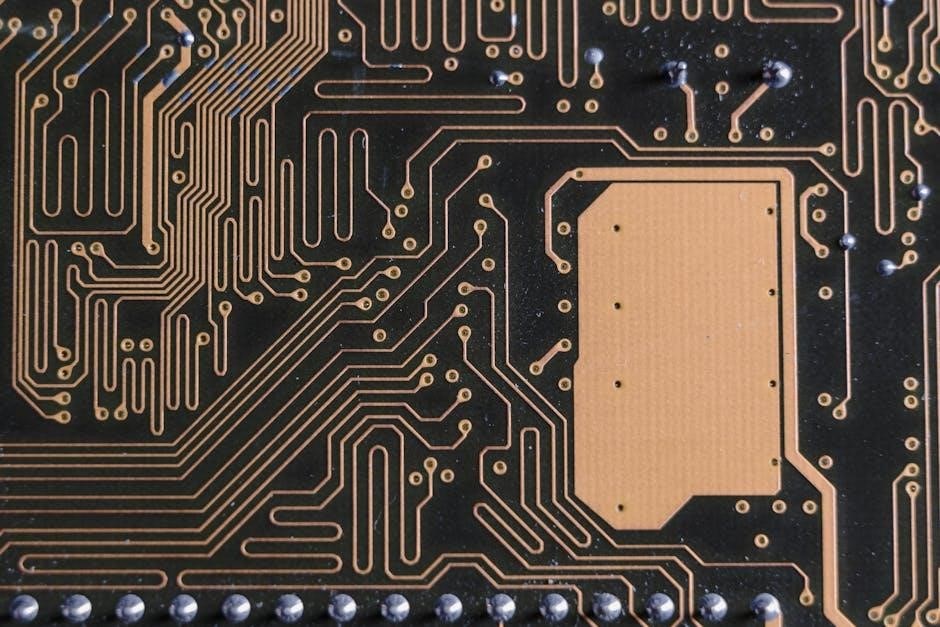1.1 Definition and Overview
The integumentary system, comprising skin, hair, nails, and glands, serves as the body’s protective barrier. It regulates temperature, aids in fluid balance, and synthesizes vitamin D.
The integumentary system is the body’s largest organ, consisting of skin, hair, nails, and associated glands. It acts as a protective barrier against external factors like pathogens, UV radiation, and temperature extremes. The system plays a crucial role in maintaining homeostasis by regulating body temperature, aiding in fluid balance, and synthesizing vitamin D. The skin, its primary component, is composed of layers: the epidermis, dermis, and subcutaneous tissue. These layers work together to provide sensation, prevent water loss, and protect internal organs. Associated structures like sweat and sebaceous glands further contribute to its functions, ensuring the body’s overall health and integrity. This system is essential for survival, making it a fundamental area of study in anatomy and physiology.
1.2 Importance of the Integumentary System
The integumentary system is vital for maintaining the body’s integrity and overall health. It acts as a protective barrier, safeguarding against pathogens, UV radiation, and physical damage. By regulating body temperature through sweating and shivering mechanisms, it ensures internal stability. The skin also plays a role in fluid balance and the synthesis of vitamin D, which is essential for bone health. Additionally, it houses sensory receptors that enable touch, pain, and pressure perception. Its ability to prevent water loss and maintain hydration is crucial for survival. Without this system, the body would be highly susceptible to infections and environmental stressors, making it indispensable for life.
Basic Structure of the Skin
The skin consists of three main layers: the epidermis, dermis, and subcutaneous tissue. Each layer performs distinct roles in protection, regulation, and connecting the body to external stimuli.
2.1 Layers of the Skin
The skin is composed of three distinct layers: the epidermis, dermis, and subcutaneous tissue. The epidermis is the outermost, thin layer, primarily made of epithelial cells. It protects the body from external factors and produces keratin, a protein that strengthens skin cells. Beneath it lies the dermis, a thicker layer of connective tissue containing blood vessels, nerve endings, hair follicles, and glands. It plays a crucial role in sensation, temperature regulation, and skin elasticity. The subcutaneous tissue, or hypodermis, is the innermost layer, consisting of fatty tissue. It provides insulation, energy storage, and anchors the skin to underlying muscles and bones, ensuring overall structural integrity.
2.2 Epidermis: Composition and Function
The epidermis is the outermost layer of the skin, composed primarily of keratinocytes, which produce keratin. This tough, fibrous protein provides strength and rigidity, forming a protective barrier against external factors like pathogens, UV radiation, and physical abrasion. The epidermis also contains melanocytes, which produce melanin, responsible for skin pigmentation and UV protection. Additionally, Langerhans cells in the epidermis play a role in immune surveillance. The epidermis is avascular, relying on the dermis for nutrient supply. Its primary functions include safeguarding underlying tissues, preventing water loss, and aiding in the synthesis of vitamin D when exposed to sunlight. This layer continuously regenerates through a process of cell division and differentiation.
2.3 Dermis: Composition and Function
The dermis is the thick, fibrous layer beneath the epidermis, comprising connective tissue. It consists of collagen and elastin fibers, which provide strength and elasticity. The dermis is divided into two layers: the papillary dermis (thin, superficial layer) and the reticular dermis (thicker, deeper layer). It contains blood vessels, nerve endings, hair follicles, and glands (sweat and sebaceous). The dermis plays a crucial role in regulating body temperature, aiding sensation, and producing sebum and sweat. It also supports immune responses through lymphatic vessels and macrophages. The dermis ensures skin flexibility and hydration, making it essential for overall skin health and function. Its rich vascular supply allows for efficient nutrient delivery and waste removal.
2.4 Subcutaneous Tissue: Role and Significance
The subcutaneous tissue, also known as the hypodermis, is the deepest layer of the integumentary system. It lies beneath the dermis and is composed primarily of adipose tissue, which stores fat for energy. This layer acts as a shock absorber, protecting internal organs from external impacts. It also plays a role in thermoregulation by insulating the body and retaining heat. Additionally, the subcutaneous tissue helps anchor the skin to underlying muscles and bones, providing structural support. It contains blood vessels and nerve endings, aiding in circulation and sensation. This layer is crucial for maintaining overall bodily functions, including energy storage and protection against environmental stressors.
Functions of the Integumentary System
- Protects against external factors like pathogens and UV radiation.
- Regulates body temperature through sweating and vasoconstriction.
- Provides sensation through nerve endings.
- Synthesizes vitamin D for bone health.
- Maintains fluid balance.
3.1 Protection Against External Factors
The integumentary system acts as the body’s first line of defense against external threats. The skin’s layered structure provides a physical barrier, preventing pathogens and foreign substances from entering the body. Melanin protects against harmful UV radiation, while keratin strengthens skin cells to resist mechanical damage. Sweat and sebaceous glands contribute to antimicrobial defenses, maintaining a protective acidic pH on the skin’s surface. This system also shields internal organs from environmental stressors, such as extreme temperatures and chemicals, ensuring overall bodily integrity and health. Its protective functions are vital for preventing infections and maintaining homeostasis.
3.2 Regulation of Body Temperature
The integumentary system plays a crucial role in maintaining body temperature through various mechanisms. The skin acts as a thermoregulatory organ, adjusting heat loss and gain based on environmental conditions. Sweating is a key process, as it cools the body through evaporation. Blood vessels in the dermis dilate or constrict to regulate blood flow near the surface, releasing or conserving heat. Hair also contributes by providing insulation, while subcutaneous fat layers offer additional thermal protection. These mechanisms ensure the body maintains a stable internal temperature, essential for proper physiological functions. This thermoregulatory function is vital for overall health and survival in varying environmental conditions.
3.3 Sensation and Nerve Endings
The integumentary system contains sensory nerve endings that enable the detection of various stimuli, such as touch, pressure, pain, temperature, and vibration. These nerve endings are distributed throughout the skin, with specific types of receptors specialized for different sensations. For example, Pacinian corpuscles detect vibration and pressure, while thermoreceptors respond to temperature changes. Sensory nerve fibers transmit these signals to the brain, allowing for conscious perception of the environment. This sensory function is crucial for reacting to harmful stimuli, maintaining balance, and interacting with the world around us. The skin’s nervous system plays a vital role in protecting the body and facilitating adaptive responses to external conditions.
3.4 Synthesis of Vitamin D
The integumentary system plays a crucial role in vitamin D synthesis. When UV radiation from sunlight interacts with the skin, it triggers the production of cholecalciferol, a precursor to vitamin D. This process occurs in the epidermis, specifically in the stratum basale and stratum spinosum. Vitamin D is essential for calcium absorption, bone health, and immune function. The synthesized vitamin D is then transported to the liver and kidneys for further processing. Without adequate sun exposure, vitamin D deficiency can occur, leading to conditions like rickets or osteomalacia. This highlights the integumentary system’s role in maintaining overall health beyond skin protection.
3.5 Maintenance of Fluid Balance
The integumentary system aids in maintaining fluid balance through the regulation of sweat production and water loss. Sweat glands produce sweat, which evaporates from the skin’s surface, helping to cool the body and regulate fluid levels. The skin acts as a barrier, preventing excessive water loss while allowing controlled perspiration. This process is crucial for homeostasis, ensuring the body retains adequate fluids. Additionally, the dermis contains blood vessels that help circulate fluids and regulate their distribution. Dysfunctions in this system, such as excessive sweating or impaired barrier function, can disrupt fluid balance, leading to conditions like dehydration or edema. Thus, the integumentary system is vital for maintaining proper hydration and overall bodily functions.

Associated Organs and Structures
Associated organs include hair, nails, and skin glands. Hair provides insulation and protection, while nails protect sensitive tips of fingers and toes. Glands produce oils and sweat, maintaining skin health and regulating body temperature. These structures work together to support the integumentary system’s functions. They are essential for overall protection and physiological balance. The system’s accessory organs contribute to its protective, regulatory, and sensory roles. Understanding these components is key to comprehending the integumentary system’s complexity and importance. This section covers the role of each organ and their interdependence in maintaining bodily functions. Their functions are vital for daily survival and health.
4.1 Hair: Structure and Function
Hair is a keratin-based structure produced by hair follicles in the dermis. The hair shaft is the visible part, while the root is anchored in the follicle. It provides insulation, reducing heat loss, and protects against environmental factors like UV radiation. Hair also aids in sensory perception through nerve endings in the follicle. The growth cycle includes phases: anagen (growth), catagen (transitional), and telogen (resting). This cycle ensures continuous hair renewal. Hair’s texture and color vary, influenced by genetics and pigmentation. It plays a crucial role in identity and social communication, while also contributing to the integumentary system’s protective functions. Understanding hair’s structure and function is essential for appreciating its role in human physiology.
4.2 Nails: Composition and Purpose
Nails are hardened keratin structures at the tips of fingers and toes, serving protective and functional roles. The nail plate is the visible part, anchored by the root beneath the skin. The nail bed, rich in blood vessels, supports growth. Nails protect sensitive tips from injury and assist in tasks requiring precision, like picking small objects. They also act as indicators of overall health, with changes in color or texture signaling conditions like anemia or infections. Proper nail care is essential for hygiene and preventing fungal or bacterial infections. Understanding nail composition and purpose highlights their importance in the integumentary system’s protective and sensory functions.
4;3 Glands in the Skin
The skin contains various glands that perform essential functions. Sweat glands, also known as sudoriferous glands, produce sweat to regulate body temperature. Sebaceous glands secrete sebum, an oily substance that moisturizes and protects the skin. Ceruminous glands in the ear canal produce cerumen, or earwax, to protect against dust and infections. Meibomian glands in the eyelids produce meibum, an oily layer that prevents tear evaporation. Mammary glands, found in breasts, produce milk for nourishment. These glands work together to maintain skin health, prevent infection, and support bodily functions. Understanding their roles is crucial for appreciating the integumentary system’s complexity and importance in overall health.
4.4 Sebaceous and Sweat Glands
Sebaceous glands produce sebum, an oily substance that lubricates and protects the skin and hair. They are most concentrated on the face, scalp, and torso. Sweat glands, or sudoriferous glands, are distributed across the body and produce sweat to regulate body temperature. Eccrine glands, the most common type, release sweat directly onto the skin’s surface, while apocrine glands are primarily found in the armpits and genital area, producing a milky secretion that becomes odoriferous when broken down by bacteria. These glands play vital roles in maintaining skin health, preventing infection, and supporting thermoregulation. Their proper function is essential for overall bodily homeostasis and protection.

Common Disorders and Conditions
The integumentary system is susceptible to various disorders, including skin cancer, eczema, psoriasis, infections, and wounds. These conditions highlight the importance of skin health and early diagnosis.
5.1 Skin Cancer: Types and Risk Factors
Skin cancer is a prevalent condition affecting the integumentary system, with types including melanoma, basal cell carcinoma, and squamous cell carcinoma. Melanoma is the most severe, arising from melanocytes. Basal cell carcinoma is less aggressive but common, while squamous cell carcinoma develops from keratinocytes. Risk factors include prolonged UV exposure, fair skin, family history, and precancerous lesions like actinic keratosis. Early detection is critical for effective treatment.
5.2 Inflammatory Conditions: Eczema and Psoriasis
Eczema, or atopic dermatitis, is a chronic inflammatory condition characterized by red, itchy, and scaly skin. It often results from allergic reactions or genetic predisposition. Psoriasis, another autoimmune disorder, causes thick, scaly patches due to overactive skin cell growth. Both conditions can be triggered by stress, environmental factors, or immune system imbalances. Symptoms include redness, itching, and flaky skin, which can significantly impact quality of life. Treatment options include topical corticosteroids, phototherapy, and lifestyle modifications. While there is no cure, managing these conditions through proper care can reduce symptoms and improve skin health.
5.3 Infectious Diseases Affecting the Skin
Infectious diseases affecting the skin can be caused by bacteria, viruses, or fungi. Bacterial infections like impetigo and cellulitis lead to redness, swelling, and pus-filled sores. Viral infections, such as warts and herpes simplex, result in localized lesions or blisters. Fungal infections, including ringworm and candidiasis, cause itching, scaling, and discolored patches. These conditions often spread through direct contact or compromised skin barriers. Proper hygiene, antibiotics, antiviral, or antifungal medications are essential for treatment. If left untreated, these infections can lead to severe complications, such as systemic infections or scarring. Early diagnosis and treatment are crucial to manage symptoms and prevent further spread.
5.4 Wound Healing and Repair
Wound healing is a complex and vital function of the integumentary system, involving multiple stages to restore skin integrity. The process begins with hemostasis, where bleeding is controlled through clot formation. Next, the inflammatory phase cleans the wound site, with white blood cells fighting infections. Proliferation follows, where granulation tissue forms, and collagen synthesis strengthens the wound. Finally, remodeling occurs, refining tissue structure and strength. Factors like nutrition, age, and health influence healing efficiency, with conditions such as diabetes potentially slowing recovery. Proper care, including keeping wounds moist and clean, and using antibiotics, can prevent infection and promote healing. The immune and circulatory systems support this process, ensuring the body’s protective barrier is effectively restored.

Worksheet Questions and Answers
This section provides answers to worksheet questions about the integumentary system, including labeling skin layers, identifying glands, and understanding skin functions. Answers are clear and concise.
6.1 Labeling the Layers and Structures of the Skin
This worksheet requires identifying and labeling the epidermis, dermis, and subcutaneous tissue. Students match terms like sweat glands, hair follicles, and nerve endings to their locations. Key structures include arrector pili muscles, sebaceous glands, and sensory nerve fibers. Proper labeling demonstrates understanding of skin anatomy. The exercise also involves identifying pores, blood vessels, and the hair shaft. Correct answers highlight the relationship between skin layers and their functions, such as protection, temperature regulation, and sensation. This activity reinforces knowledge of the integumentary system’s complex architecture and its role in maintaining bodily functions. Accurate labeling ensures a strong foundation in dermatological anatomy.
6.2 Types of Glands in the Skin
The skin contains two primary types of glands: sweat glands and sebaceous glands. Sweat glands produce sweat, aiding in thermoregulation, while sebaceous glands secrete sebum, lubricating the skin and hair. Both glands are distributed across the body but vary in concentration. Sweat glands are more abundant on the palms and soles, whereas sebaceous glands are densely found on the face and scalp. This worksheet requires identifying and describing these glands, their locations, and functions. Understanding their roles helps in grasping skin physiology and its importance in maintaining bodily functions. Correct answers highlight the distinction between eccrine and apocrine sweat glands, as well as the composition and purpose of sebum.
6.3 Seven Functions of the Skin
The skin performs seven essential functions: protection, regulation of body temperature, sensation, synthesis of vitamin D, maintenance of fluid balance, absorption, and excretion. Protection involves shielding the body from pathogens, UV radiation, and physical damage. Regulation of body temperature is achieved through sweating and blood vessel constriction or dilation. Sensation is enabled by nerve endings that detect touch, pain, pressure, and temperature. Vitamin D synthesis occurs when sunlight interacts with skin cells. Fluid balance is maintained by controlling water loss through sweating. Absorption of certain substances, like medications, and excretion of wastes via sweat are additional roles. This worksheet requires identifying and explaining these functions in detail.
6.4 Matching Pigments to Their Descriptions
This exercise requires matching skin pigments to their descriptions. Melanin, the primary pigment, is responsible for skin and hair color, with eumelanin producing brown/black tones and pheomelanin producing red/yellow tones. Carotene, derived from diet, gives skin a yellow/orange hue, while hemoglobin in blood vessels contributes to redness. Matching involves linking each pigment to its role, such as melanin protecting DNA from UV damage. This activity enhances understanding of skin color regulation and pigment functions, aiding in worksheet completion. Accurate matching demonstrates knowledge of how pigments interact to maintain skin health and appearance. This section is crucial for grasping dermatological basics.

Practice Test and Feedback
A 31-question practice test covers skin structures, functions, and disorders. Each question is analyzed for correctness, with detailed feedback explaining right and wrong answers clearly.
7.1 Multiple Choice Questions on Skin Structures
The practice test includes 31 multiple-choice questions focusing on skin structures, such as layers, glands, and nerve endings. Questions assess knowledge of epidermal composition, dermal components, and subcutaneous tissue roles. Students identify sensory nerve fibers, arrector pili muscles, and sebaceous glands from descriptions. The quiz also covers pigments like melanin, matching them to their functions. Feedback provides detailed explanations, highlighting correct answers and clarifying common misconceptions. This section helps reinforce understanding of skin anatomy and its functional significance in the integumentary system, ensuring students grasp key concepts before progressing to advanced topics.
7.2 Correct and Incorrect Answer Analysis
The practice test provides detailed feedback, indicating correct and incorrect answers with explanations. Correct answers are highlighted, reinforcing key concepts like skin layer identification and gland functions. Incorrect responses are analyzed, explaining why choices were wrong and offering the right information. For example, questions about melanin’s role are clarified, ensuring understanding of its pigmentary functions. This section helps students identify knowledge gaps and address misconceptions, such as confusing arrector pili muscles with sweat gland functions. The analysis aids in improving comprehension of skin anatomy and physiology, ensuring a stronger grasp of the integumentary system for future studies and applications.

Case Studies and Practical Applications
Real-life scenarios involving skin disorders, burns, and wounds demonstrate the integumentary system’s role in protection and healing. Practical applications include clinical treatments and wound care strategies.
8.1 Real-Life Scenarios Involving Skin Disorders
Real-life scenarios involving skin disorders highlight the integumentary system’s critical role in health. For instance, patients with severe burns face challenges in temperature regulation and fluid balance. Similarly, individuals with skin cancer, such as melanoma, require timely intervention to prevent metastasis. Inflammatory conditions like eczema and psoriasis demonstrate the system’s response to internal and external stressors. Additionally, infectious diseases like fungal infections or bacterial abscesses showcase the skin’s protective functions. These scenarios underscore the importance of understanding skin anatomy and physiology, enabling effective diagnosis and treatment. Practical applications include wound care, dermatological treatments, and preventive measures to maintain skin integrity and overall well-being.
8.2 Application of Integumentary System Knowledge
Understanding the integumentary system is vital for various practical applications, particularly in medical and cosmetic fields. Dermatologists rely on this knowledge to diagnose and treat skin disorders, such as eczema, psoriasis, and skin cancer. Nurses and healthcare professionals use it to manage wound care, ensuring proper healing and preventing infections. In cosmetology, knowledge of skin structure and function guides product development and safe procedures. Educators teach patients about skin health, promoting prevention of diseases like melanoma. Researchers apply this knowledge to develop new treatments for skin conditions and improve surgical techniques. This understanding also aids in creating protective gear and sunscreen, highlighting its everyday relevance.
Additional Resources and References
Recommended worksheets and guides provide detailed exercises on labeling skin layers, matching pigments, and understanding gland functions. Online tools offer interactive quizzes and practice tests for comprehensive learning.
9.1 Recommended Worksheets and Study Guides
Various worksheets are available to enhance understanding of the integumentary system. These include exercises on labeling skin layers, identifying glands, and matching pigments to descriptions. One worksheet focuses on the epidermis, dermis, and subcutaneous tissue, while another provides a 31-question practice test covering skin structures and functions. Additional guides offer blank-fill exercises, such as completing sentences about skin protection and temperature regulation. These resources are ideal for students seeking to reinforce their knowledge through interactive and practical learning methods.
9.2 Online Tools for Learning the Integumentary System
Several online tools facilitate comprehensive learning of the integumentary system. Interactive diagrams and virtual dissections allow students to explore skin layers and associated structures in detail. Multiple-choice question banks and practice tests provide opportunities for self-assessment. Additionally, video tutorials explain complex processes like melanin synthesis and sweat gland function. Forums and discussion groups offer spaces for clarifying doubts and sharing insights. These resources cater to diverse learning styles, ensuring a well-rounded understanding of the integumentary system’s anatomy and physiology;
